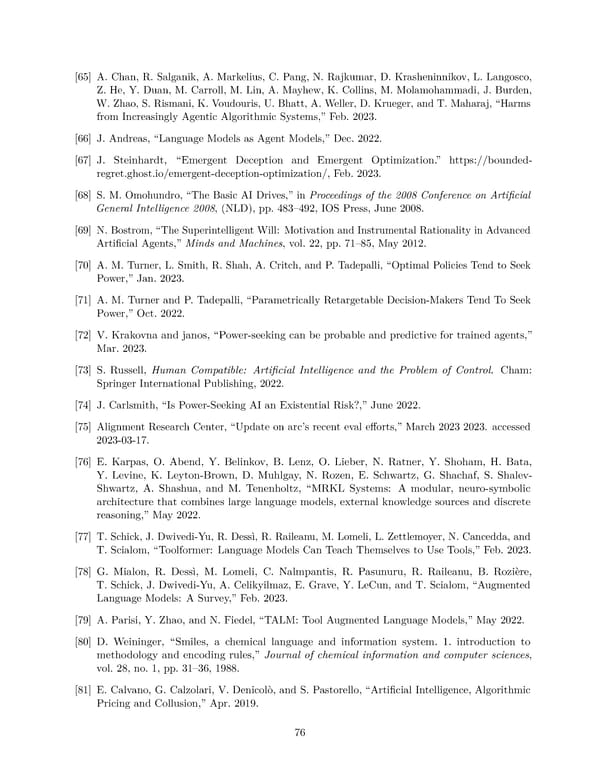[65] A. Chan, R. Salganik, A. Markelius, C. Pang, N. Rajkumar, D. Krasheninnikov, L. Langosco, Z. He, Y. Duan, M. Carroll, M. Lin, A. Mayhew, K. Collins, M. Molamohammadi, J. Burden, W.Zhao, S. Rismani, K. Voudouris, U. Bhatt, A. Weller, D. Krueger, and T. Maharaj, “Harms from Increasingly Agentic Algorithmic Systems,” Feb. 2023. [66] J. Andreas, “Language Models as Agent Models,” Dec. 2022. [67] J. Steinhardt, “Emergent Deception and Emergent Optimization.” https://bounded- regret.ghost.io/emergent-deception-optimization/, Feb. 2023. [68] S. M. Omohundro, “The Basic AI Drives,” in Proceedings of the 2008 Conference on Artificial General Intelligence 2008, (NLD), pp. 483–492, IOS Press, June 2008. [69] N. Bostrom, “The Superintelligent Will: Motivation and Instrumental Rationality in Advanced Artificial Agents,” Minds and Machines, vol. 22, pp. 71–85, May 2012. [70] A. M. Turner, L. Smith, R. Shah, A. Critch, and P. Tadepalli, “Optimal Policies Tend to Seek Power,” Jan. 2023. [71] A. M. Turner and P. Tadepalli, “Parametrically Retargetable Decision-Makers Tend To Seek Power,” Oct. 2022. [72] V. Krakovna and janos, “Power-seeking can be probable and predictive for trained agents,” Mar. 2023. [73] S. Russell, Human Compatible: Artificial Intelligence and the Problem of Control. Cham: Springer International Publishing, 2022. [74] J. Carlsmith, “Is Power-Seeking AI an Existential Risk?,” June 2022. [75] Alignment Research Center, “Update on arc’s recent eval efforts,” March 2023 2023. accessed 2023-03-17. [76] E. Karpas, O. Abend, Y. Belinkov, B. Lenz, O. Lieber, N. Ratner, Y. Shoham, H. Bata, Y. Levine, K. Leyton-Brown, D. Muhlgay, N. Rozen, E. Schwartz, G. Shachaf, S. Shalev- Shwartz, A. Shashua, and M. Tenenholtz, “MRKL Systems: A modular, neuro-symbolic architecture that combines large language models, external knowledge sources and discrete reasoning,” May 2022. [77] T. Schick, J. Dwivedi-Yu, R. Dessì, R. Raileanu, M. Lomeli, L. Zettlemoyer, N. Cancedda, and T. Scialom, “Toolformer: Language Models Can Teach Themselves to Use Tools,” Feb. 2023. [78] G. Mialon, R. Dessì, M. Lomeli, C. Nalmpantis, R. Pasunuru, R. Raileanu, B. Rozière, T. Schick, J. Dwivedi-Yu, A. Celikyilmaz, E. Grave, Y. LeCun, and T. Scialom, “Augmented Language Models: A Survey,” Feb. 2023. [79] A. Parisi, Y. Zhao, and N. Fiedel, “TALM: Tool Augmented Language Models,” May 2022. [80] D. Weininger, “Smiles, a chemical language and information system. 1. introduction to methodology and encoding rules,” Journal of chemical information and computer sciences, vol. 28, no. 1, pp. 31–36, 1988. [81] E. Calvano, G. Calzolari, V. Denicolò, and S. Pastorello, “Artificial Intelligence, Algorithmic Pricing and Collusion,” Apr. 2019. 76
 GPT-4 Page 35 Page 37
GPT-4 Page 35 Page 37